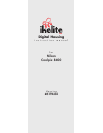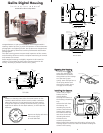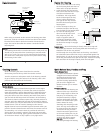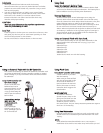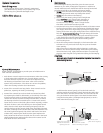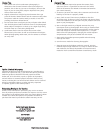
17
P
P
h
h
o
o
t
t
o
o
T
T
i
i
p
p
s
s
The number one rule in underwater photography is
eliminate as much water between camera and subject as
possible Get as close as you can to the subject then use the
zoom If you are using flash subjects beyond feet (m)
w
ill not have much color
Digital cameras have a slight lag time between when you
press the shutter release button and the camera actually takes
the picture Hold the camera steady a second or two after
p
ressing the shutter release button
Do not shoot down on subjects as they will quite often blend
i
nto the background and be difficult to see in the photograph
Shoot subjects straight on or shoot up at a slight angle using
the blue water as a contrasting background
Underwater flash is used to restore the warmer colors
f
iltered out by the water as well as to illuminate the subject
When photographing underwater set the camera to use flash
on every shot
I
I
k
k
e
e
l
l
i
i
t
t
e
e
L
L
i
i
m
m
i
i
t
t
e
e
d
d
W
W
a
a
r
r
r
r
a
a
n
n
t
t
y
y
All Ikelite products are warranted against any manufacturing
defects for a period of one () year from the date of purchase
Defective products should be returned prepaid to Ikelite
Ikelite will at its discretion repair or replace such products
and will return to customer prepaid All other claims of any
nature including but not limited to bulb failure are not covered
Except as mentioned above no other warranty expressed
or implied applies to this Ikelite product
R
R
e
e
t
t
u
u
r
r
n
n
i
i
n
n
g
g
P
P
r
r
o
o
d
d
u
u
c
c
t
t
s
s
f
f
o
o
r
r
S
S
e
e
r
r
v
v
i
i
c
c
e
e
Ikelite is most interested in performing any service to assure
that all products perform as intended For repair or service return
the product to the address below with your name address phone
number and a brief description of the problem Evidence of
purchase date must be provided to obtain warranty service
I
I
k
k
e
e
l
l
i
i
t
t
e
e
U
U
n
n
d
d
e
e
r
r
w
w
a
a
t
t
e
e
r
r
S
S
y
y
s
s
t
t
e
e
m
m
s
s
W
W
r
r
d
d
S
S
t
t
r
r
e
e
e
e
t
t
I
I
n
n
d
d
i
i
a
a
n
n
a
a
p
p
o
o
l
l
i
i
s
s
I
I
N
N
U
U
S
S
A
A
e
e
m
m
a
a
i
i
l
l
:
:
i
i
k
k
e
e
l
l
i
i
t
t
e
e
@
@
i
i
k
k
e
e
l
l
i
i
t
t
e
e
c
c
o
o
m
m
w
w
w
w
w
w
i
i
k
k
e
e
l
l
i
i
t
t
e
e
c
c
o
o
m
m
D
D
i
i
g
g
i
i
t
t
a
a
l
l
v
v
18
G
G
e
e
n
n
e
e
r
r
a
a
l
l
T
T
i
i
p
p
s
s
Due to the power required to operate the camera flash
and LCD screen it is a good idea to start each dive with a
fresh set of batteries Use NiMH or LITHIUMion batteries
(see camera manual)
As soon as you enter the water take a moment and check the
housing to see that it is properly sealed
Next check to see if there are any bubbles on the face
of the lens port If there are take your finger and remove them
If there are bubbles on the lens port they can produce soft focus
spots in your photographs
Due to the light sensitivity of digital cameras they may
overexpose closeup photographs when using an external flash
If closeup photos are constantly overexposed use the camera
menu and change the external strobe exposure to or higher
S
hoot a few test photographs changing the strobe exposure
compensation until you are satisfied with the results
Shoot with the smallest aperture possible when shooting
closeup with flash
Use the macro mode for closeup photographs
Shoot pictures at the highest resolution Several printing
methods require high resolution It is easy to reduce the size
and resolution but almost impossible to increase size and
resolution from a small file and obtain a satisfactory result



